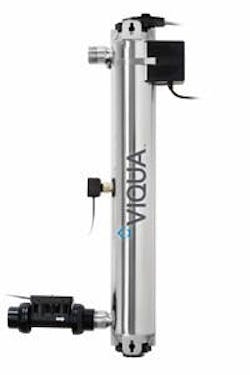POE: A Complete Solution
Ultraviolet (UV) disinfection provides a chemical-free, low-maintenance option for treating private water sources, including wells, surface water and harvested rainwater. While each of those sources presents unique water quality challenges that can impact the effectiveness of a UV system, the fundamental premise is the same. For UV treatment to be completely effective, the UVC light generated by the lamp needs to be able to pass through the water unimpeded so it can deactivate any microorganisms present. This is why knowing the water source and quality at all times is so important. However, it is equally important to consider water usage patterns at the site.
Case in Point
A Canadian sporting club used a private water well and was required to install disinfection to meet the requirements of the provincial Ministry of Health for small drinking water systems. In the U.S., this type of facility, which can include schools, factories, churches and hospitals, would be considered a non-transient, non-community water system. The sporting club would see low traffic and water use throughout the week, but then a major influx of people and a surge in water usage on weekends, especially when competitions were held.
The initial water test results indicated the presence of iron and hardness. Both of these common groundwater contaminants can negatively impact UV transmission (UVT), which is a measure of the ability to transmit UVC rays through water. Generally, for effective disinfection, the UVT of the source water needs to be greater than 75%. Hardness minerals are troublesome because over time they can deposit on or foul the quartz sleeve surrounding the UV lamp. This can result in decreased UV dose and incomplete disinfection. This challenge was adequately addressed at the sporting club with the installation of appropriate pretreatment, including water softening, air injection for oxidation of the iron and filtration. The UV system was up and running smoothly and both the customer and the installer were initially satisfied with the results.
Sound the Alarms
Monitored UV systems go into alarm mode when UVT drops, indicating risk of incomplete disinfection. At first, all was well at the sporting club, but over time the UV system began to alarm. It was only occasional in the beginning, prompting quartz sleeve and sensor cleaning. But the alarms grew persistently worse. Hypotheses were put forward and troubleshooting began. Was it micro-bubbles from the encapsulated air injection system? Was it the sporadic water demand? The first step was to perform another water analysis. This time, it showed the presence of tannins.
Tannins commonly are found in surface water sources such as lakes, rivers and rainwater, and consist of natural organic matter that is picked up as water passes through peaty soil or decaying vegetation. Tannins can easily cause UVT to drop to between 75% and 50%. It turns out that although the sporting club drew its water from a drilled well, the well was shallow at just about 12 ft deep, and it was clearly under the influence of surface water. Recent heavy rains and snowmelt had a significant impact on water quality and UVT, so the decision was made to convert to a chlorination system for oxidation. This addressed the water quality issue but not the challenge of inconsistent water usage.
‘Real-Time’ Dosing With Flowmeter
Most UV water treatment products certified to NSF/ANSI Standard 55 Class A are optimized and calibrated for operating at a fixed maximum flow rate. This makes sense for larger systems, where the flow is unlikely to fluctuate drastically. With smaller systems, like the one installed in the sporting club, the flow was far from consistent. To overcome this, a subsequent upgrade to the UV system was needed—one that could recognize when there was less-than-maximum flow. The suggestion was to add a flowmeter to the Viqua Pro UV unit. The custom-engineered flowmeter offers real-time dosing and fail-safe flow detection. By measuring the actual flow instead of assuming it is a fixed rate, the system tracks UV dose in the chamber.
Though somewhat skeptical at first, the installer was eager for a solution. Checking in several months after installation, he reported that the alarms and, perhaps most importantly, the customer complaints, had stopped.
Pretreatment is a critical part of effective disinfection with UV light. When you have a thorough understanding of the source water and potential impact of various water contaminants, it is easy to design a water treatment system that will optimize the effectiveness of the UV system. It also is critical to take water usage patterns into consideration. If water usage is going to be sporadic or minimal at times, look for a UV system certified to NSF/ANSI 55 with integrated flowmeter technology for real-time dosing.
Download: Here
